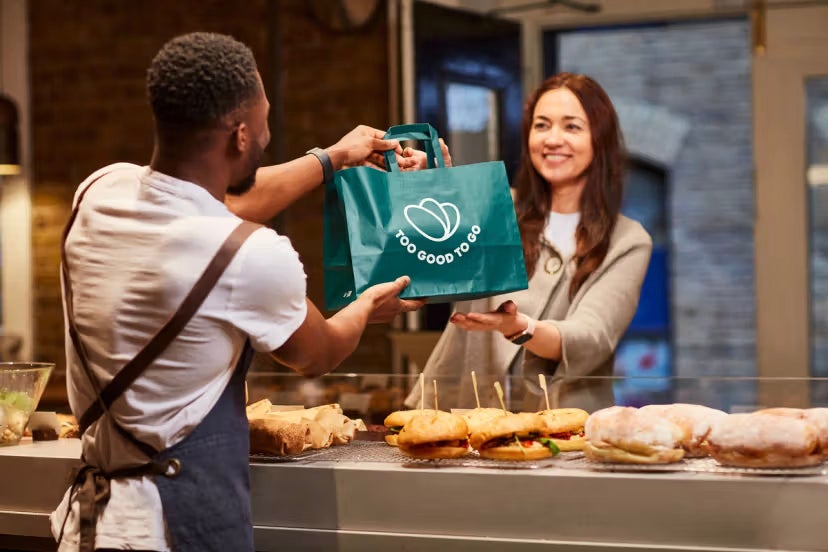A woman sits in her kitchen, showing off the contents of her bag in a video she’s filming for TikTok. Her excitement permeates through the screen as she babbles about the “rare find” she’s picked up, as though she’s about to show off an incredible handbag from a vintage shop or designer piece picked up on sale. But no; the bag she hoists onto the table is made of paper and comes from Pret a Manger, although the fervour with which she pulls out a porridge pot, a cheese and tomato croissant, and a savoury breakfast dish implies a far more high-end offering.
The video maker jokes that she got an “adrenaline rush” picking up this bag for just £3, and laughs, but I totally know what she means. The excitement of picking up a bag purchased through Too Good To Go, a popular app that allows its users to pick up so-called “mystery bags” of surplus food from retailers for a reduced price, is something I know well. I’ve been using Too Good To Go since I moved to London six years ago, and in that time have got some cracking deals on everything from fresh pasta to crates of beer cans. It’s an app I check and use often, one that means my freezer is always stocked up with really good bread and fancy pastries for a fraction of their retail cost.
Founded in Copenhagen in 2015, Too Good To Go was invented with one clear intention: fighting food waste for the sake of the planet and its people. For many of us, the idea of surplus food going to waste, particularly in a time when so many cannot afford to feed themselves and their kids, feels particularly galling, yet it’s estimated that a third of the world’s food produced every year is binned. Over a decade, the company has amassed 100 million registered users and saved more than 400 million meals, with 175,000 retailers across the globe signing up to sell their excess food.
Sophie Trueman is Too Good To Go’s country director for the UK and Ireland, and says that reducing the environmental impact of food waste remains the company’s number one priority. “We believe that we cannot afford to waste food,” she tells me. “It’s too valuable – for the planet, for society and for the economy. That’s why we’re doubling down on solutions that are scalable, flexible and designed to drive long-term impact… We believe that at scale, small actions make a big impact. And every meal matters.”
With food waste estimated to cost the UK £22bn every year, it’s no surprise that the app has really taken off in the UK. All you have to do is buy a “mystery bag” and agree to pick it up within an allotted time period, then turn up, swipe and collect. In the six years since I first started using Too Good To Go (I also used Karma and peer-to-peer app Olio at the time, although these are much less popular now), I’ve watched them grow in popularity among retailers. Open Too Good To Go at any point, and I’ll see offerings from supermarkets (Co-op, Aldi), chain restaurants and cafes (Costa, Greggs, Gail’s), and independent cafes and shops, all with bags of goodies on offer.

Consumers love them too. Many of the best bags are so desirable they get snapped up within minutes – some TikTokers say they set alarms to get the most popular bags in their areas, although I’ve never attempted this myself – and I’ll often run into others collecting their own bags at pick up. This is in London, where the app is particularly prolific, but I check Too Good To Go when I visit a new city like others check Tinder (call it scoping out the local talent) to see what’s up for grabs.
Preventing food waste and procuring a good deal are the primary drivers of Too Good To Go’s popularity. But there’s also a good dollop of intrigue involved as to what you get in a mystery bag. Some outlets will offer separate bags based on food type, meal or dietary requirements, and you can hedge your bets on bags that have a higher average rating from previous recipients who have rated based on the food quality, quantity and variety, but generally it’s just whatever’s left at the end of the day.
That’s where the videos come in too. In fact, these “what’s in my bag” clips, more in the vein of a supermarket haul than a celebrity sitting down with Vogue to show off their Chanel crossbody, have become a subgenre of their own. They feed a curiosity (what on earth goes in a Toby Carvery mystery bag?), yet in doing so, add to the fascination in the app.
One such video maker is Rackie from Berkshire, who, like me, has been using Too Good To Go for more than five years. The haul videos are a fairly recent addition to her usual money-saving and birdwatching content, she tells me, having been asked to make them by her friends who wanted to know what’s in the bags she picks up from Co-op or Aldi. Based in Berkshire, where the options on the app are far more limited, Rackie will only grab a bag from her local town if she’s in the area for work anyway. “It sort of feels a bit counterintuitive trying to save food waste, but then you’re spending money on petrol going miles away from home just to pick up a bag of food which you may or may not have bought in the first place,” she says. “I really don’t like food waste… but I know for some people, it’s more, ‘I want to save money’, or for a lot of people, it’s just a bit fun.”
For Rackie, that element of play is important, because getting a bag is always “a bit of a gamble”. A mountain of cheddar might be some people’s idea of heaven, but the man who received 36 individually wrapped truckles of cheese in a mystery box from Aldi in a clip was probably a little bewildered, even if they did only cost him £3.30. While I’ve never had any bags go that badly, I’ve certainly had disappointing offerings. Yes, the prices are so low you can’t really complain (although they’re definitely rising), but there’s something particularly disappointing about the promise of a hidden gem deal that turns out to be underwhelming.
Multiple portions of cheese is by no means a normal Aldi offering on the app; in one of Rackie’s own hauls from the budget supermarket, she receives a loaf of bread, crisps, vegetables, fruit, pastries, tinned fish. In her video, Rackie says she’ll pass on any items she doesn’t want to her dad, who lives nearby and, she jokes to me, will “eat anything”, or her neighbours. “I think actually, if I didn’t have that option, I would be more reluctant to get the boxes,” she explains.
But when these bags become a desirable commodity that people will trek across town or set alarms on their phone for, it can feel like that original anti-food waste messaging gets lost. One such video served to me on TikTok shows a girl complaining about being “mugged off” after receiving an egg mayo sandwich from Costa. “Sorry, but that’s going straight in the bin,” she says, disgusted. Now, I might be an egg mayo apologist, but doesn’t throwing away any food items you don’t want destroy the whole point of a food waste app? The commenters beneath her video agree. “People have clearly forgotten what Too Good To Go is,” one comment reads.
This is something the people at Too Good To Go are acutely aware of. Trueman says that their mission – “to inspire and empower everyone to fight food waste together” – remains at the forefront of the app. Users can see how much carbon dioxide they’ve helped avoid by saving meals, and they prioritise talking about the environmental impact on their social media channels. “We make it clear that every action in the app contributes to a larger environmental and social cause,” she says.
People are, of course, allowed to have preferences when it comes to food, and there’s no guarantee that a bag will meet those or any dietary requirements. You can be smart with it; I don’t eat meat, and so tend to pick up bags from vegan restaurants or ask if they have vegetarian bags when I’m there, but it’s still a gamble, with the onus now on me to give these away to prevent the items from becoming food waste. Too Good To Go was just the middleman.
While recently picking up a Too Good To Go bag from a local coffee shop (one piece of cake and two pastries for £3.40 – not bad), I got chatting to the barista about how they use the app. She told me they used to have a real issue with food waste, especially on more perishable items like pastries. Pointing to a single piece of lemon drizzle cake, she explained that that was all they had left today after they’ve packed the bags. That, she considers a job well done.
Generally, everyone, shop staff included, is keen to reduce the amount of food being wasted. But it’s harder to do than people realise. Zoe Adjey, a senior lecturer in hospitality at the University of East London, explains that there are several concerns that stop companies from distributing surplus food. There’s the worry that it might “inadvertently encourage theft” among staff, alongside food safety and liability issues. “Businesses are deeply concerned about bacterial growth in surplus food and the serious risk of causing food poisoning,” she explains. “The legal and reputational consequences of food-borne illness create a strong incentive for businesses to err on the side of caution when disposing of surplus food.”
This highlights the very real problem that food waste apps are bridging. Yes, I’d far rather any items that have just passed their display date go to food banks or even employees, but many businesses – especially big chains – have really strict rules on how they dispose of food waste for fear of being sued. Reduced “yellow sticker” items were once seen as a source of shame, but as Adjey puts it, apps like Too Good To Go have “transformed food waste from a stigmatised last resort into a mainstream money-saving and environmentally conscious choice”.
So while the thought of food waste being something you can buy, and has even become gentrified to the point where people are making haul videos about it, can make me feel a little icky, Too Good To Go is clearly making a difference when it comes to reducing food waste and raising awareness around it. As Rackie expertly puts it: “There’s probably an element of greenwashing to everything, but if the ultimate result is that food doesn’t get wasted, then that’s a good thing, however you get to that point.”
Tesco’s new AI cameras are just the start — is this the end of private shopping?
Stephen Fry shares rare comments on 30-year age gap with husband
Ageing as a woman is like a bereavement – but most of us are stuck in denial
Doctors can now detect heart failure by scanning this other body part
McDonald’s Snack Wraps will be here soon as Popeyes rivalry heats up
Hate chia pudding? This lemon and blueberry version might convert you







